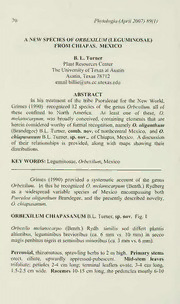
A new species of Orbexilum (Leguminosae) from Chiapas, Mexico PDF
Preview A new species of Orbexilum (Leguminosae) from Chiapas, Mexico
70 Phytologia (April2007) 89(1) A NEW SPECIES OF ORBEX1LUM(LEGUM1NOSAE) FROM CHIAPAS, MEXICO B. L. Turner Plant Resources Center The University ofTexas at Austin Austin, Texas 78712 email [email protected] ABSTRACT In his treatment of the tribe Psoraleeae for the New World, Grimes (1990) recognized 12 species of the genus Orbexilum, all of these confined to North America. At least one of these, O. melanocarpum, was broadly conceived, containing elements that are herein considered worthy offormal recognition, namely O. oliganthum (Brandegee) B.L. Turner, comb. nov. ofnorthcentral Mexico, and O. chiapasanum B.L. Turner, sp. nov., ofChiapas, Mexico. A discussion of their relationships is provided, along with maps showing their distributions. KEY WORDS: Leguminosae, Orbexilum, Mexico Grimes (1990) provided a systematic account of the genus Orbexilum. In this he recognized O. melanocarpum (Benth.) Rydberg as a widespread variable species of Mexico encompassing both Psoralea oliganthum Brandegee, and the presently described novelty, O. chiapasanum. ORBEXILUM CHIAPASANUM B.L. Turner, sp. nov. Fig. 1 Orbexilo melanocarpo (Benth.) Rydb. similis sed differt plantis altioribus, leguminibus brevioribus (ca. 6 mm vs. 10 mm) in secco magis penbitus nigris et seminibus minoribus (ca. 3 mm vs. 6 mm). Perennial, rhizomatous, sprawling herbs to 2 m high. Primary stems erect, ciliate, upwardly appressed-pubescent. Mid-stem leaves trifoliate; petioles 2-4 cm long; terminal leaflets ovate, 3-4 cm long, 1.5-2.5 cm wide. Racemes 10-15 cm long, the peduncles mostly 6-10 Phytologia (April2007)89(1) 71 cm long. Calyx 6-7 mm long, glandular-punctate, the lobes 4-5 mm mm long. Flowers purple to violet-purple; petals 7-8 long, the banner purple with a white eye. Legumes ovoid, ca. 6 mm long, 4 mm wide; mm mm seeds ca. 3.5 long, 2.0 wide. TYPE: MEXICO. CHIAPAS: Mpio. Amatenango del Valle, 1835 m, 12 Jun 1945, E. Matuda 5821 (Holotype: LL; isotype TEX). ADDITIONAL SPECIMENS EXAMINED: MEXICO. CHIAPAS: Mpio. La Trinitaria. E of Laguna Tziscao, Monte Bello Natl. Park, 1300 m, 18 Nov. 1980, Breedlove & Almeda 47547 (LL). Mpio. Ocosingo. 21.2 mi from the intersection with hiway 190, on road to Palenque, 11 Mar 1985, Grimes 2620, 2628 (TEX). Mpio. Oxchuc: 5 mi ESE of Oxchuc, 6 Mar 1985, Grimes 2619 (TEX). San Juan Cancuc, Ohteel, 5000 ft, 21 Apr 1992, Brett 931 (TEX). As indicated in Fig.1, O. chiapasamnn is confined to the state of Chiapas, Mexico, hence its name. It is readily distinguished from both O. melanocarpum and O. oliganthum by its taller habit and smaller legumes having smallerseeds. Orbexilum oliganthum (Brandegee) B.L. Turner, comb. nov. Fig. 2 Based upon Psoralea oligantha Brandegee, Univ. Calif. Public. Bot. 4: 179. 1911. The type ofthis taxon is from the higher elevations of Sierra de Parras, southern Coahuila, Mexico. Grimes (1990), in his reduction of this taxon to synonymy under his broad concept of O. melanocarpum, notes: "Some populations found above 2400 m on mountain ranges in Nuevo Leon, Coahuila and Zacatecas consist of diminutive plants usually 15 cm tall or shorter, with leaflets 3.0 cm long or less, flowers mm 9-10 long, broadly acute calyx teeth, and fruits with beak about 2.5 mm. These plants correspond to Psoralea oligantha Brandegee. However, the character states are not unique to these mountain populations, and are not found on all populations within the same area. The broadly acute calyx teeth, perhaps the character most constant in these populations, grade into the more typical linear-triangular teeth characteristic ofthe species." 72 Phytologia (April2007) 89(1) I cannot agree with the submergence of this taxon within O. melanocarpum. There appears to be a syndrome of characters which mark the species, most ofwhich are called to the fore by Grimes. Nor do the characters concerned appear to intergrade into those of O. melanocarpum. Combined with its high elevational habitats, and relatively restricted distribution (Fig. 2), O. oliganthum appears to be worthy ofrecognition at the specific level. ACKNOWLEDGEMENTS Dot maps in the present paper are based upon specimens housed at LL, TEX. I am grateful to my colleague, Guy Nesom , for the Latin diagnosis. LITERATURE CITED Grimes, J.W. 1990. A revision ofthe New World species ofPsoraleeae (Leguminosae: Papilionoideae). Mem. New York Bot. Gard. 61: 1-114. Phytologia (April2007) 89(1) 73 Fig. 1. Distribution ofOrbe.xilum melanocarpum (closed circles) and O. chiapasamim (open circles). 74 Phytologia (April2007) 89(1) Fig. 2. Distribution ofOrbexilum oliganthum.
